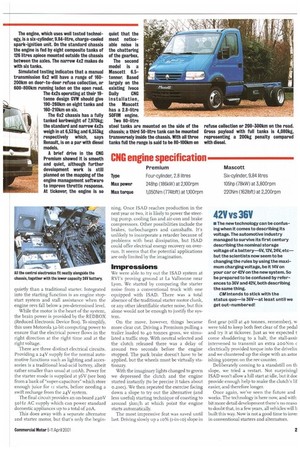:M recently attended the latest in a series of Z.enault
Page 26

Page 27

If you've noticed an error in this article please click here to report it so we can fix it.
VI's technical briefings—top of the genda was an innovative charging/starting ystem, followed by a preview of a gas-powered ruck range. Colin Barnett reports.
SAD (Integrated Starter/ Alternator/Damper) is a product of Continental Automotive Systems, a division of the German group better known for its tyres. The project was launched to velop an electrical engine vibration limper, but that aspect soon became .condary as other possibilities nerged.
The system comprises three main ements: the electrical machine -elf; the electronic control system; id the storage media. Replacing the )nyentional flywheel, and currently adding acts as a highly efficient alternator. At rest, ? to 40kg of weight and ioimm of length to however, ISAD's function is reversed to spin Le engine/gearbox, the water-cooled motor the engine into life much more quickly and
ISAD adds 101mm to the overall length of the engine gearbox.
Nothing new
III The RVI/Continental effort may be the first time that this technology has been successfully drawn together in one application, but some of the individual components have been around for years.
Combined charging and starting is a very old concept, probably best known as the DynaStart. We've been able to trace its history up until the late fifties when it was still being used in the Villiers two-stroke engines that powered Bond three-wheelers, where its relatively feeble torque output was not a major problem.
Stop-and-go systems are more recent, being most widely used in the early eighties on the first Audi 80, before a temporary return to obscurity. That changed last year when it was introduced as an option on the latest Mercedes-Benz Sprinter.
However, despite its popularity in countries such as Switzerland and Austria, Mercedes reports negligible interest in the UK.
quietly than a traditional starter. Integrated into the starting .function is an engine stopstart system and stall assistance when the engine revs fall below a pre-determined level.
While the motor is the heart of the system, the brain power is provided by the RE DBOX (Reduced Electronic Device Box). To simplify, this uses Motorola 32-bit computing power to ensure that the electrical power flows in the right direction at the right time and at the right voltage.
There are three distinct electrical circuits. Providing a 24V supply for the normal automotive functions such as lighting and accessories is a traditional lead-acid battery, albeit rather smaller than usual at iioAh. Power for the starter mode is supplied at 36V (see box) from a bank of "super-capacitors" which store enough juice for ri starts, before needing a swift recharge from the 24V system.
The final circuit provides an on-board 22oV 5oHz AC supply which can power standard domestic appliances up to a total of 2oA.
This does away with a separate alternator and starter motor, but that's only the begin fling. Once ISAD reaches production in the next year or two, it is likely to power the steering pump, cooling fan and air-con and brake compressors. Other possibilities include the brakes, turbochargers and camshafts. It's unlikely to incorporate a retarder because of problems with heat dissipation, but ISAD could offer electrical energy recovery on overrun. It seems that the potential applications are only limited by the imagination.
Impressions
We were able to try out the ISAD system at RVI's proving ground at La Valbonne near Lyon. We started by comparing the starter noise from a conventional truck with one equipped with ISAD. There was a total absence of the traditional starter motor clunk, or any other identifiable starter noise, but this alone would not be enough to justify the system.
On the move, however, things became more clear cut. Driving a Premium pulling a trailer loaded to 40 tonnes gross, we simulated a traffic stop. With neutral selected and the clutch released there was a delay of around two seconds before the engine stopped. The park brake doesn't have to be applied, but the wheels must be virtually stationary.
With the imaginary lights changed to green we depressed the clutch and the engine started instantly (to be precise it takes about o.2sec). We then repeated the exercise facing down a slope to try out the alternative (and less useful) starting technique of coasting to around 5km/h at which point the engine starts automatically.
The most impressive feat was saved until last Driving slowly up aro% (I-in-io) slope in
42V vs 36V
• The new technology can be confusing when it comes to describing its voltage. The automotive industry managed to survive its first century describing the nominal storage voltage of a battery-6V, 12V, 24V, etc— but the scientists now seem to be changing the rules by using the maximum charging voltage, be it 14V on your car or 42V on the new system. So be prepared to be confused by references to 36V and 42V, both describing the same thing.
Vkfintencis to stick with the status quo—le 36V—at least until we get out-numbered!
first gear (still at 40 tonnes, remember), w were told to keep both feet clear of the pedal and try it at tickover. Just as we expected t come shuddering to a halt, the stall-assli intervened to transmit an extra zooNm c electrically provided torque into the drivelin and we chuntered up the slope with an astor ishjng 3oorpm on the rev counter.
Deliberately coming to a standstill on th slope, we tried a restart. Not surprising] ISAD won't allow a hill start at idle, but it doe provide enough help to make the clutch's lif easier, and therefore longer.
Once again, we've seen the future and works. The technology is here now, and with bit more detail development there's no reaso to doubt that, in a few years, all vehicles will b built this way. Now is not a good time to inve: in conventional starters and alternators.
























































































